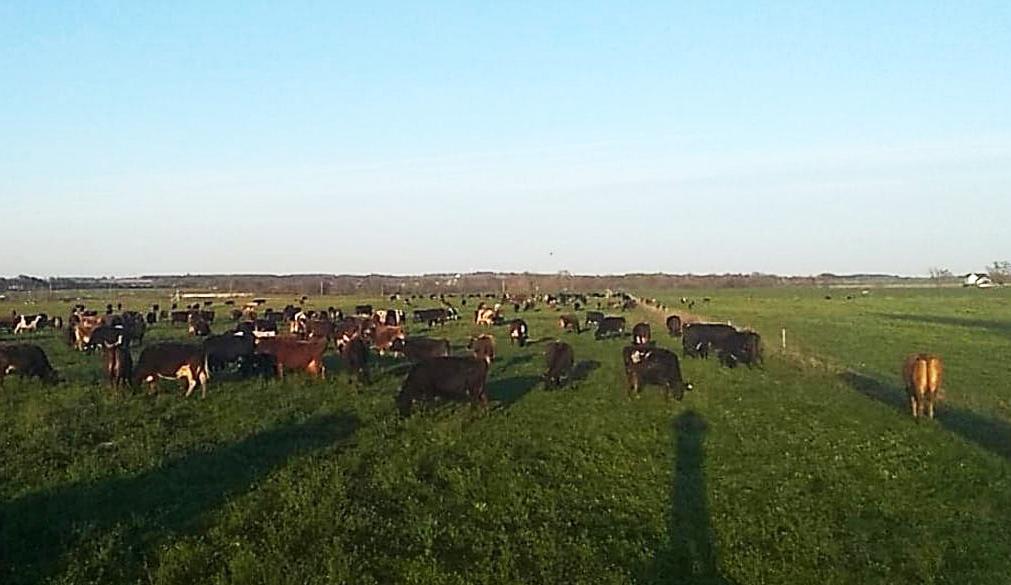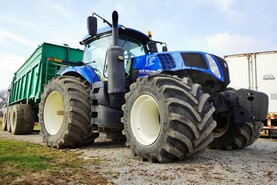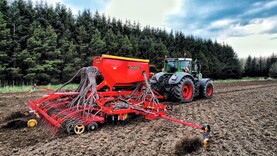Emerald Dairies is an Irish-owned dairy farming business in southwest Missouri, United States. Located in the grain belt, the scale of farming in this region is enormous. Land is parcelled in square miles of 640ac each. Some tillage farms in the area own single blocks of land up to 1,500ac in one parcel. Corn (maize) and soya are the main crops.
In the middle of all this is Emerald Dairies, running four grass-based dairy farms. The Emerald model is a low-cost, grass-based system, very similar to New Zealand or Ireland, which is totally different to most confinement-based dairy farms in the US.
Focussing on cost rather than production, Jersey-cross cows and Kiwi genetics are the base for the herds. Poor prices for milk and grain in the US created an opportunity for low-input dairying in Missouri. Land and feed can be purchased relatively cheaply, so low-cost production systems, like that operated by Emerald, are able to make money despite a low milk price. The farms are all spring-calving, with cows outdoors 365 days of the year.
Kenoma Dairy is one of the four farms owned by Emerald Dairies – the company formed by Niall Murphy and Gary Nolan in 2009. Gary has since left to set up his own farm in Ireland. The Kenoma farm encompasses 227ha and 600 cows, looked after by farm manager Rory Sheridan who is originally from Cavan.
Two to three people can run the farm for most of the year, with two students providing extra help in spring. All the cows are calved outdoors and grass is grazed all year, when possible. The cows weigh 425kg and produce around 340-360kg MS/cow. In the US, milk is measured in hundredweight. Average cost of production on the Kenoma farm is $11.50/hundred weight (cwt) or 21c/l in euro-litre equivalent. In the context of American dairy production, this is $5.50/cwt (9c/l) lower than the average confinement system, which has costs of $17/cwt or 30c/l. The most efficient of US producers has a cost of production of $14/cwt (25c/l) .
The weather is the biggest challenge in Missouri, with freezing winters (-16°C) and summer droughts (36°C). Cows are comfortable with the extremes once the weather remains dry and diet is enough to maintain body condition. A wet year would cause the system and cows to come under more pressure, as grazing conditions deteriorate very quickly.
Kenoma’s heavy clay soils have suffered long-term compaction from intensive tillage, which has affected the permeability of the soils making drainage very poor. Wet springs seldom happen in Missouri, but spring of 2019 was an exception. Heavy rainfall from mid-March to May ensured grazing conditions were very difficult for long periods. This affected the amount of fresh grass in the cows’ diet. The flat topography and small creeks were often overwhelmed with deluges of rain, the heaviest of which brought 6in in eight hours. The system must be flexible because of the inconsistency of the weather, so having cheap alternative feed cushions the cost when the weather is challenging. Spring grass is still the most cost-efficient feed for the farm, so the focus is on maximising the window for good growth.
Grass management
On average, Kenoma has grown 13.5t DM/ha over the last five years. The summer of 2018 brought a prolonged drought and heatwave, causing a forage shortage for 2019. This was bridged using purchased maize silage at a cost of 10c/kg DM and old meadow hay bales from neighbouring farms. Grass variety on the farm is important.
Irish varieties would not survive the temperatures experienced in winter or summer. For this reason, a French-bred tetraploid variety called Albion ryegrass is widely used. It has a stress resistance gene, becoming dormant under harsh conditions with no loss of quality. This ensures its longevity over the growing season. It has an ability to restart in autumn when temperatures reduce, creating better growing conditions. Clover is used extensively in the swarths. Its ability to deliver milk solids and grow rapidly in spring and summer make it a good option at Kenoma.
Winter wheat for grazing in spring was trialled in 2018/2019 to try and front-load the farm with extra dry matter coming into spring.
“The wet soils at Kenoma did not suit the wheat; we are still learning and trying new things to get grass right. Since we began dairying here we have had to learn how grass plants grow to maximise it in the system,” says Niall.
Wilson Springs, another Emerald-owned farm located 25 miles away on drier soils, had a better trial, with the wheat adding an extra 3t DM in spring at a cost of $20/t. However, in cold or wet conditions the wheat can cause nitrate poisoning in cows. So diet and ration intake must help ensure cows do not gorge on high-nitrogen green leaf. Clover was under-sown in wheat paddocks. Once the wheat started to head out it was cut for silage and the clover took over, along with summer grasses, for the remainder of the season. There is high risk of bloat in mid- to late spring. Monitoring bloat adds to the workload and the risk must be assessed depending on grazing conditions. Safety breaks are used to try and increase stem intake of cows, increasing fibre in their diet and reducing the risk of bloating. Bloat oil in the water is also used – distributed to all drinkers.
Supplementation
The challenges with grass growth change from year to year, but basic principles of management apply. The team measures, manages and utilises as much as they can. The quality of grass is highest in spring and growth can vary depending on soil temperature. Once it reaches 5°C the farm starts growing and will grow upwards of 70kg DM/day until the summer drought slows growth.
Four pivot irrigators cover 65% of the grazing block and are used throughout the summer to grow grass and keep cows comfortable in the extreme heat. Concentrate feeding per cow varies depending on grass growth, but the average over the last five years is 750kg/cow. Grain composition changes two or three times across the year depending on protein requirements. Milk is tested by the co-op for MUNs (milk urea nitrogen) daily, which shows if cows need more or less protein.
The farm feeds about 80-100kg meal in spring and then 300-400kg in the summer, with the balance fed in autumn. In spring, the fertiliser used is usually chicken litter, but DAP (straight phosphate) and urea/sulphate of ammonia were spread this year instead to ensure accurate soil tests in June. Sulphate of ammonia is important as the nitrogen content in the soil works at lower temperatures in this form.
Outlook and opportunity
Milk price has hovered around $17/cwt (30c/l) for the past year, but profits will take a hit with all the extra feed brought onto the farm for the difficult spring. Growth and ground conditions recovered well, meaning a good summer for grazing.
Emerald Dairies is continuing to expand. What started out as a share-milking venture is now a large landowner, with over 2,000ac between owned and leased land, 2,000 cows being milked. Future success largely depends on the availability of skilled workers who can manage grass well. Farm managers like Rory, Michael Cox, James Doherty and Hoyt Hines, who operate the other farms, are buying into the herds that they are managing and effectively starting their own businesses. For the people running Emerald Dairies, America is still the land of opportunity.
Owen Cashman is a fourth-year agricultural science student at UCD and recipient of the Irish Farmers Journal/ASA travel bursary. He did a placement with Emerald Dairies last spring.
Read more
Grass+Dairy: autumn grazing targets on heavy soils
The west’s awake: large-scale dairy operation in Roscommon
Emerald Dairies is an Irish-owned dairy farming business in southwest Missouri, United States. Located in the grain belt, the scale of farming in this region is enormous. Land is parcelled in square miles of 640ac each. Some tillage farms in the area own single blocks of land up to 1,500ac in one parcel. Corn (maize) and soya are the main crops.
In the middle of all this is Emerald Dairies, running four grass-based dairy farms. The Emerald model is a low-cost, grass-based system, very similar to New Zealand or Ireland, which is totally different to most confinement-based dairy farms in the US.
Focussing on cost rather than production, Jersey-cross cows and Kiwi genetics are the base for the herds. Poor prices for milk and grain in the US created an opportunity for low-input dairying in Missouri. Land and feed can be purchased relatively cheaply, so low-cost production systems, like that operated by Emerald, are able to make money despite a low milk price. The farms are all spring-calving, with cows outdoors 365 days of the year.
Kenoma Dairy is one of the four farms owned by Emerald Dairies – the company formed by Niall Murphy and Gary Nolan in 2009. Gary has since left to set up his own farm in Ireland. The Kenoma farm encompasses 227ha and 600 cows, looked after by farm manager Rory Sheridan who is originally from Cavan.
Two to three people can run the farm for most of the year, with two students providing extra help in spring. All the cows are calved outdoors and grass is grazed all year, when possible. The cows weigh 425kg and produce around 340-360kg MS/cow. In the US, milk is measured in hundredweight. Average cost of production on the Kenoma farm is $11.50/hundred weight (cwt) or 21c/l in euro-litre equivalent. In the context of American dairy production, this is $5.50/cwt (9c/l) lower than the average confinement system, which has costs of $17/cwt or 30c/l. The most efficient of US producers has a cost of production of $14/cwt (25c/l) .
The weather is the biggest challenge in Missouri, with freezing winters (-16°C) and summer droughts (36°C). Cows are comfortable with the extremes once the weather remains dry and diet is enough to maintain body condition. A wet year would cause the system and cows to come under more pressure, as grazing conditions deteriorate very quickly.
Kenoma’s heavy clay soils have suffered long-term compaction from intensive tillage, which has affected the permeability of the soils making drainage very poor. Wet springs seldom happen in Missouri, but spring of 2019 was an exception. Heavy rainfall from mid-March to May ensured grazing conditions were very difficult for long periods. This affected the amount of fresh grass in the cows’ diet. The flat topography and small creeks were often overwhelmed with deluges of rain, the heaviest of which brought 6in in eight hours. The system must be flexible because of the inconsistency of the weather, so having cheap alternative feed cushions the cost when the weather is challenging. Spring grass is still the most cost-efficient feed for the farm, so the focus is on maximising the window for good growth.
Grass management
On average, Kenoma has grown 13.5t DM/ha over the last five years. The summer of 2018 brought a prolonged drought and heatwave, causing a forage shortage for 2019. This was bridged using purchased maize silage at a cost of 10c/kg DM and old meadow hay bales from neighbouring farms. Grass variety on the farm is important.
Irish varieties would not survive the temperatures experienced in winter or summer. For this reason, a French-bred tetraploid variety called Albion ryegrass is widely used. It has a stress resistance gene, becoming dormant under harsh conditions with no loss of quality. This ensures its longevity over the growing season. It has an ability to restart in autumn when temperatures reduce, creating better growing conditions. Clover is used extensively in the swarths. Its ability to deliver milk solids and grow rapidly in spring and summer make it a good option at Kenoma.
Winter wheat for grazing in spring was trialled in 2018/2019 to try and front-load the farm with extra dry matter coming into spring.
“The wet soils at Kenoma did not suit the wheat; we are still learning and trying new things to get grass right. Since we began dairying here we have had to learn how grass plants grow to maximise it in the system,” says Niall.
Wilson Springs, another Emerald-owned farm located 25 miles away on drier soils, had a better trial, with the wheat adding an extra 3t DM in spring at a cost of $20/t. However, in cold or wet conditions the wheat can cause nitrate poisoning in cows. So diet and ration intake must help ensure cows do not gorge on high-nitrogen green leaf. Clover was under-sown in wheat paddocks. Once the wheat started to head out it was cut for silage and the clover took over, along with summer grasses, for the remainder of the season. There is high risk of bloat in mid- to late spring. Monitoring bloat adds to the workload and the risk must be assessed depending on grazing conditions. Safety breaks are used to try and increase stem intake of cows, increasing fibre in their diet and reducing the risk of bloating. Bloat oil in the water is also used – distributed to all drinkers.
Supplementation
The challenges with grass growth change from year to year, but basic principles of management apply. The team measures, manages and utilises as much as they can. The quality of grass is highest in spring and growth can vary depending on soil temperature. Once it reaches 5°C the farm starts growing and will grow upwards of 70kg DM/day until the summer drought slows growth.
Four pivot irrigators cover 65% of the grazing block and are used throughout the summer to grow grass and keep cows comfortable in the extreme heat. Concentrate feeding per cow varies depending on grass growth, but the average over the last five years is 750kg/cow. Grain composition changes two or three times across the year depending on protein requirements. Milk is tested by the co-op for MUNs (milk urea nitrogen) daily, which shows if cows need more or less protein.
The farm feeds about 80-100kg meal in spring and then 300-400kg in the summer, with the balance fed in autumn. In spring, the fertiliser used is usually chicken litter, but DAP (straight phosphate) and urea/sulphate of ammonia were spread this year instead to ensure accurate soil tests in June. Sulphate of ammonia is important as the nitrogen content in the soil works at lower temperatures in this form.
Outlook and opportunity
Milk price has hovered around $17/cwt (30c/l) for the past year, but profits will take a hit with all the extra feed brought onto the farm for the difficult spring. Growth and ground conditions recovered well, meaning a good summer for grazing.
Emerald Dairies is continuing to expand. What started out as a share-milking venture is now a large landowner, with over 2,000ac between owned and leased land, 2,000 cows being milked. Future success largely depends on the availability of skilled workers who can manage grass well. Farm managers like Rory, Michael Cox, James Doherty and Hoyt Hines, who operate the other farms, are buying into the herds that they are managing and effectively starting their own businesses. For the people running Emerald Dairies, America is still the land of opportunity.
Owen Cashman is a fourth-year agricultural science student at UCD and recipient of the Irish Farmers Journal/ASA travel bursary. He did a placement with Emerald Dairies last spring.
Read more
Grass+Dairy: autumn grazing targets on heavy soils
The west’s awake: large-scale dairy operation in Roscommon






 This is a subscriber-only article
This is a subscriber-only article









SHARING OPTIONS: